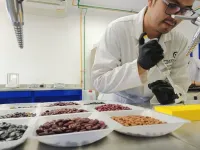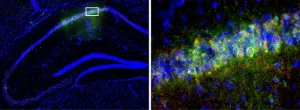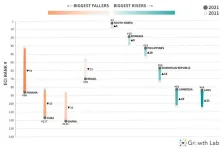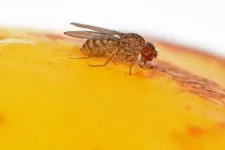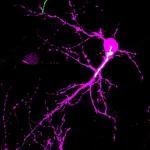(Press-News.org) (Memphis, Tenn.—July 28, 2023) The influenza (flu) virus is constantly undergoing a process of evolution and adaptation through acquiring new mutations. Scientists at St. Jude Children’s Research Hospital have added a new layer of understanding to explain why and how flu viruses change. The “survival of the accessible” model provides a complementary view to the more widely recognized “survival of the fittest” way of evolving. The work was published today in Science Advances.
Viruses undergo a rapid evolutionary flux due to constant genetic mutations. This rapid flux is why people get a flu shot every year, as we need to tackle the latest flu variant that has emerged as the dominant strain. We often see these mutations in the context of traditional evolutionary thinking, where variant fitness determines which mutated virus emerges as a dominant strain in a population. The St. Jude team investigated this theory and defined an alternative evolutionary principle, which they propose is a key driver of evolution, termed “variant accessibility.”
The research, led by Alexander Gunnarsson, Ph.D., and M. Madan Babu, Ph.D., St. Jude Department of Structural Biology and Center of Excellence for Data-Driven Discovery, involved creating a model of mutational accessibility to help predict how and why specific mutations emerge in a population during viral evolution.
The unappreciated role of variant accessibility
The genomic alphabet only has four letters representing the nucleotides: (A)denosine, (T)hymine, (G)uanine, and (C)ytosine. Groups of three nucleotides within a protein-coding gene are called a codon. Codons act like a recipe for assembling proteins, encoding for a specific amino acid. Mutations occur when nucleotides are altered, for instance, during replication. This alteration leads to a different amino acid being used to make the protein. But not all mutations are equally likely to emerge, as Babu and Gunnarsson discovered.
“The process of genetic replication has inherent biases built in, such as the relative ease of an A to be mutated to a C rather than to a G,” Babu explained. “This means that the pool of mutants with this A-to-C mutation is larger, and surviving variants will predominantly emerge from that particular pool, even though there may be a fitter sequence with an A-to-G mutation.”
Using the influenza virus as a case study, Gunnarsson and Babu translated this concept into a mathematical model. Their model enables researchers to predict the path of future evolution based on the accessibility of a mutation. Of particular interest was exploring how specific protein sites can gain or lose the ability to be modified after acquiring a mutation. They then examined how this gain or loss influenced the protein’s function.
Phosphorylation is an example of such a modification. It occurs when a phosphate molecule is added to specific amino acids of a protein. In terms of the flu, phosphorylation can help the virus hijack the host molecular pathways for mediating successful infection. Such mutations may have been critical to influenza pandemics of the past, and it is these datasets that Gunnarsson and Babu used to develop their model.
The importance of jackpot events
The model also helped the researchers better understand a long-conceptualized mutation property, the jackpot event. These are mutations that occur by chance early in the growth of a population, leading to a continuous benefit seen throughout the descendants. “The more accessible a genotype is, the more frequent these specific jackpot events are because it’s simply a probabilistic event,” Gunnarsson explained. “If a particular gene is a hundred times more likely to acquire a specific mutation, you’ll see that jackpot event happening proportionately more frequently. These events are important in evolution and are driven primarily by how accessible the variants are.”
More accessible mutations are likely to be predominant in a population even though they may not be the fittest mutation. “If the probability of acquiring the fittest mutation is one out of hundreds of trillions,” Gunnarsson said, “the likelihood of it reaching fixation in a population, even if it’s the fittest mutation, is low. When you have multiple instances of jackpot mutations happening, statistically, the prevalence of this variant increases massively, even if it’s less fit compared to another, more fit but less accessible mutant.”
Furthering our understanding of mutational bias and predicting outcomes in evolving systems
The concept of variant accessibility is elegant in its simplicity, but like most things in nature, it is a balance of statistical probabilities. From the mutation event and differences in the probability of certain nucleotide changes to codon redundancy (multiple codons for the same amino acid), it is a delicate balance between components that drives evolutionary pathways.
“Furthering our understanding of biochemical mutational biases (e.g., during replication) in viruses can open up new directions and possibilities because it’ll give much better insights into how a virus is likely to evolve,” Babu stated. In fact, the model is being applied to historical data about how the flu virus has changed within the framework of mutational accessibility to predict viral evolution more accurately.
The ability to predict viral evolutionary outcomes based on accessibility has piqued the interest of influenza expert Richard Webby, Ph.D., of St. Jude Department of Host-Microbe Interactions and Director of the World Health Organization Collaborating Centre for Studies on the Ecology of Influenza in Animals and Birds.
“There are many scenarios in public health where we try and predict the evolutionary path of influenza viruses, including selecting the most appropriate vaccines for future influenza,” Webby said. “The ‘survival of the accessible’ model will empower these predictions and allow us to identify viruses more likely to take on worrying traits more confidently.”
This model also applies beyond influenza or even virology and steers further research into mutational biases in different diseases. In cancer, for example, the model can help answer numerous questions about pathology, such as why particular cancer-driving or drug-resistance mutations repeatedly surface.
“Our model can be applied to help predict whether a particular type of mutation is likely to emerge as a tumor driver or as a resistant mutation to a specific treatment,” Babu stated. “We hope our work will spur research into characterizing mutational biases driving viral and tumor evolution. If we can quantify and better understand the biochemical processes contributing to mutational bias, that will be invaluable to predict mutational outcomes in evolving genetic systems. The ability to predict outcomes before they happen will allow us to be prepared when they eventually unfold.”
Authors and funding
The study was supported by grants from the Medical Research Council (MC_U105185859) and ALSAC, the fundraising and awareness organization of St. Jude.
St. Jude Media Relations Contacts
Chelsea Bryant
Desk: (901) 595-0564
Cell: (256) 244-2048
chelsea.bryant@stjude.org
media@stjude.org
Rae Lyn Rushing
Desk: (901) 595-4419
Cell: (901) 686-2597
Raelyn.rushing@stjude.org
media@stjude.org
St. Jude Children's Research Hospital
St. Jude Children's Research Hospital is leading the way the world understands, treats and cures childhood cancer, sickle cell disease and other life-threatening disorders. It is the only National Cancer Institute-designated Comprehensive Cancer Center devoted solely to children. Treatments developed at St. Jude have helped push the overall childhood cancer survival rate from 20% to 80% since the hospital opened more than 60 years ago. St. Jude shares the breakthroughs it makes to help doctors and researchers at local hospitals and cancer centers around the world improve the quality of treatment and care for even more children. To learn more, visit stjude.org, read St. Jude Progress blog, and follow St. Jude on social media at @stjuderesearch.
END
Mutation accessibility fuels influenza evolution
2023-07-28
ELSE PRESS RELEASES FROM THIS DATE:
Billions in conservation spending fail to improve wild fish stocks in Columbia Basin
2023-07-28
CORVALLIS, Ore. – Four decades of conservation spending totaling more than $9 billion in inflation-adjusted tax dollars has failed to improve stocks of wild salmon and steelhead in the Columbia River Basin, according to Oregon State University research.
The study led by William Jaeger of the OSU College of Agricultural Sciences is based on an analysis of 50 years of data suggesting that while hatchery-reared salmon numbers have increased, there is no evidence of a net increase in wild, naturally spawning salmon and steelhead.
Findings were published today in PLOS One.
Jaeger, a professor of applied economics, notes that ...
Imaging shows how solar-powered microbes turn CO2 into bioplastic
2023-07-28
ITHACA, N.Y. - When considering ways to sustainably generate environmentally friendly products, bacteria might not immediately spring to mind.
However, in recent years scientists have created microbe-semiconductor biohybrids that merge the biosynthetic power of living systems with the ability of semiconductors to harvest light. These microorganisms use solar energy to convert carbon dioxide into value-added chemical products, such as bioplastics and biofuels. But how that energy transport occurs in such a tiny, complex ...
Novel Raman technique breaks through 50 years of frustration
2023-07-28
Raman spectroscopy — a chemical analysis method that shines monochromatic light onto a sample and records the scattered light that emerges — has caused frustration among biomedical researchers for more than half a century. Due to the heat generated by the light, live proteins are nearly destroyed during the optical measurements, leading to diminishing and non-reproducible results. As of recently, however, those frustrations may now be a thing of the past.
A group of researchers with the Institute for Quantum Sciences and Engineering at Texas A&M ...
Unique Mexican black and pinto bean varieties are high in healthy compounds
2023-07-28
URBANA, Ill. – Common beans are important food sources with high nutritional content. Bean seeds also contain phenolic compounds, which have antioxidant and anti-inflammatory properties that promote health. A study from the University of Illinois Urbana-Champaign and CIATEJ in Guadalajara, Mexico, explored the composition of seed coat extracts from black and pinto bean varieties unique to the Chiapas region of Southern Mexico.
“These beans are preserved among Mayan communities and grown by indigenous farmers. They are heirlooms from past generations and are important because of their cultural significance and contribution to biodiversity,” explained ...
Circadian clock gene helps mice form memories better during the day
2023-07-28
A gene that plays a key role in regulating how bodies change across the 24-hour day also influences memory formation, allowing mice to consolidate memories better during the day than at night. Researchers at Penn State tested the memory of mice during the day and at night, then identified genes whose activity fluctuated in a memory-related region of the brain in parallel with memory performance. Experiments showed that the gene, Period 1, which is known to be involved in the body’s circadian clock, is crucial for improved daytime memory performance.
The research demonstrates a link between the circadian system and memory formation ...
Neonatal stem cells from the heart could treat Crohn’s disease
2023-07-28
Research from Ann & Robert H. Lurie Children’s Hospital of Chicago found that direct injection of neonatal mesenchymal stem cells, derived from heart tissue discarded during surgery, reduces intestinal inflammation and promotes wound healing in a mouse model of Crohn’s disease-like ileitis, an illness marked by chronic intestinal inflammation and progressive tissue damage.
The study, published in the journal Advanced Therapeutics, offers a promising new and alternative treatment approach that avoids the pitfalls of current Crohn’s disease medications, including diminishing effectiveness, ...
China, Indonesia, and Vietnam lead global growth for coming decade in new Harvard Growth Lab projections
2023-07-28
Cambridge, MA – China, India, Indonesia, Uganda, and Vietnam are projected to be among the fastest-growing economies for the coming decade, according to researchers at the Growth Lab at Harvard University. The new growth projections presented in The Atlas of Economic Complexity include the first detailed look at 2021 trade data, which reveal continued disruptions from the uneven economic recovery to the global pandemic. China is expected to be the fastest-growing economy per capita, although its growth rate is smaller than gains seen over the past decade.
Growth over the coming decade is projected to take off in three growth poles, East Asia, Eastern ...
Researchers tickle rats to identify part of the brain critical for laughter and playfulness
2023-07-28
To study play behaviors in animals, scientists must be able to authentically simulate play-conducive environments in the laboratory. Animals like rats are less inclined to play if they are anxious or restrained, and there is minimal data on the brain activity of rats that are free to play. After getting rats comfortable with a human playmate, tickling them under controlled conditions, then measuring the rats’ squeaks and brain activity, a research team reports on July 27 in the journal Neuron that a structure in rat brains called the periaqueductal gray is essential for play and laughter.
“We know that vocalizations such as laughter are very ...
Scientists discover secret of virgin birth, and switch on the ability in female flies
2023-07-28
Scientists have pinpointed a genetic cause for virgin birth for the first time, and once switched on the ability is passed down through generations of females.
For the first time, scientists have managed to induce virgin birth in an animal that usually reproduces sexually: the fruit fly Drosophila melanogaster.
Once induced in this fruit fly, this ability is passed on through the generations: the offspring can reproduce either sexually if there are males around, or by virgin birth if there aren’t.
For most animals, reproduction is sexual - it involves a female’s egg being fertilised by a male’s sperm. ...
Uncovering how the Golgi apparatus impacts early postnatal neuron development
2023-07-28
Neurons are the cells that constitute neural circuits and use chemicals and electricity to receive and send messages that allow the body to do everything, including thinking, sensing, moving, and more. Neurons have a long fiber called an axon that sends information to the subsequent neurons. Information from axons is received by branch-like structures that fan out from the cell body, called dendrites.
Dendritic refinement is an important part of early postnatal brain development during which dendrites are tailored to make specific connections with appropriate axons. In a recently published paper, researchers present evidence showing how a mechanism within the neurons of a rodent involving ...


